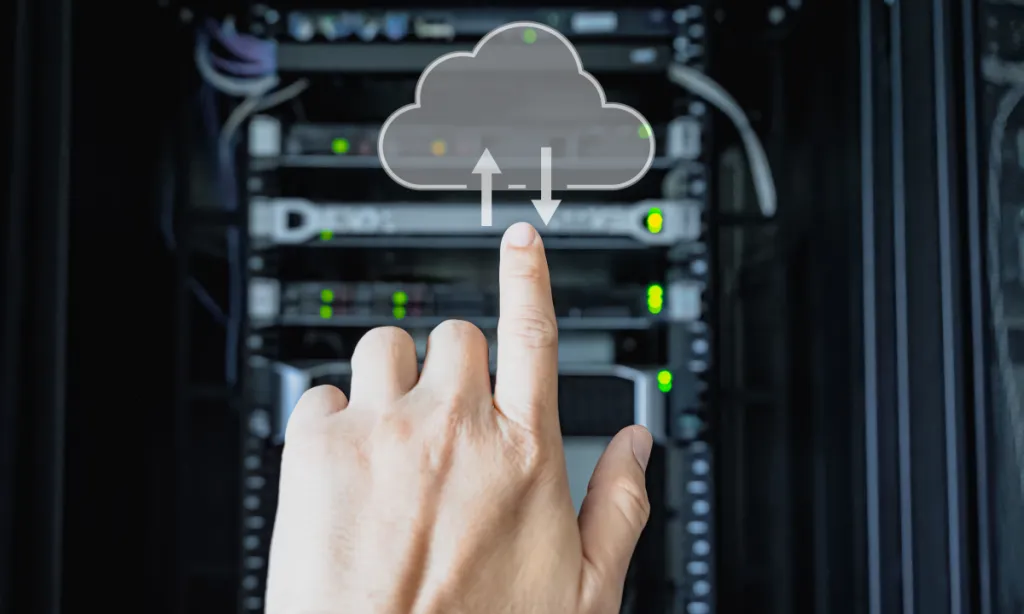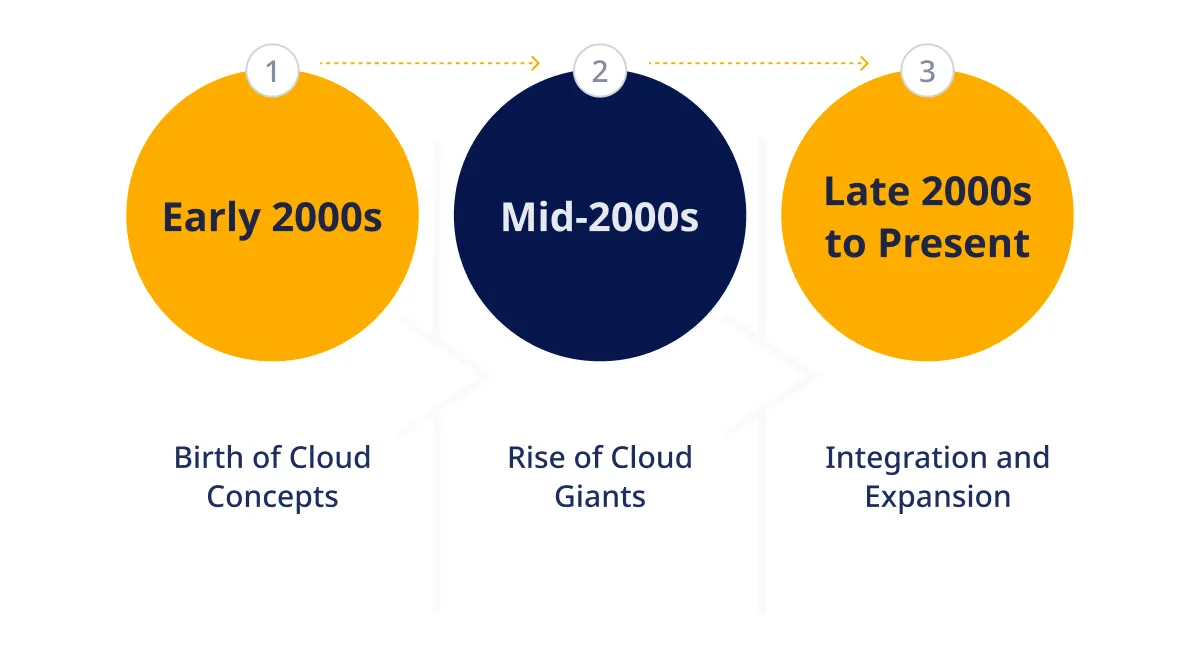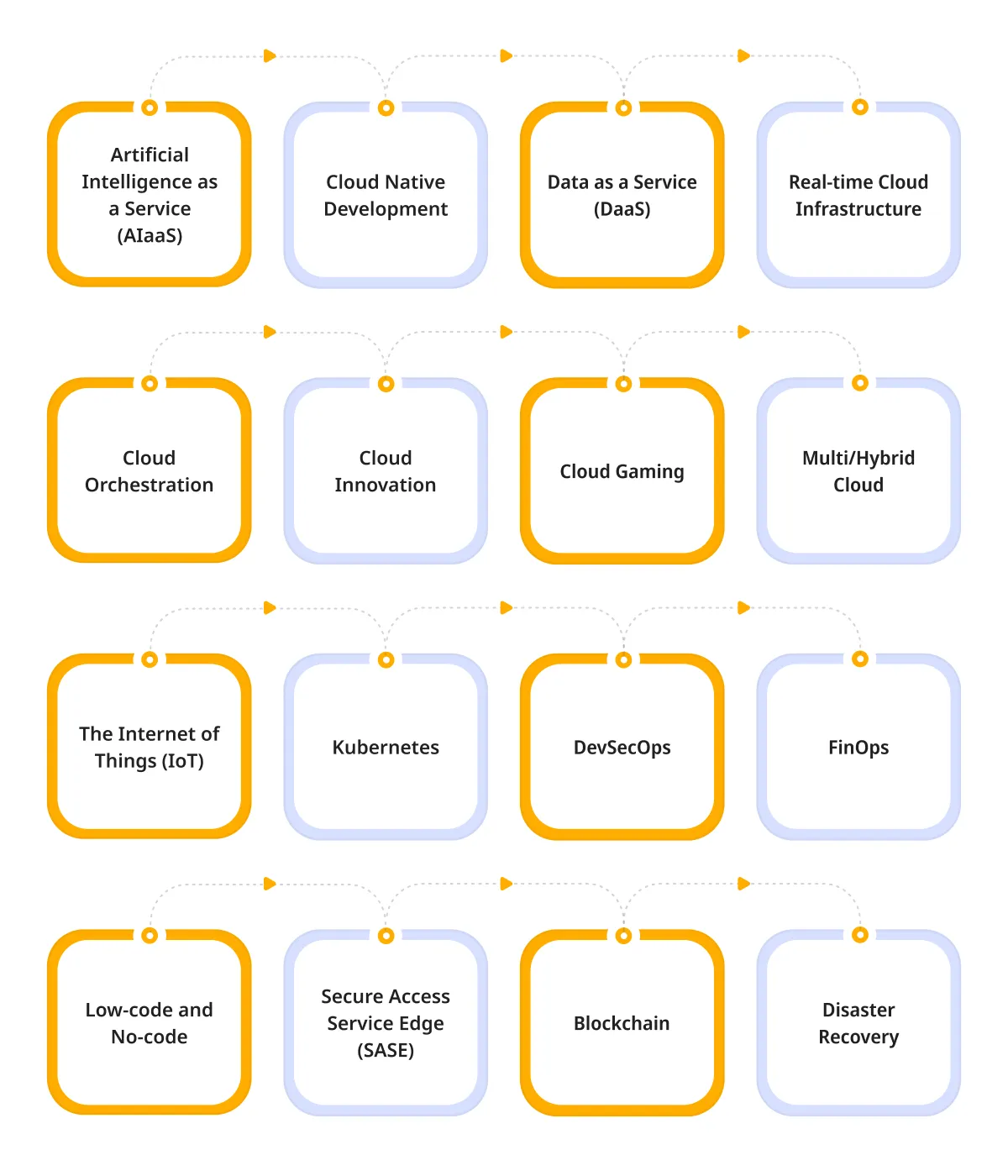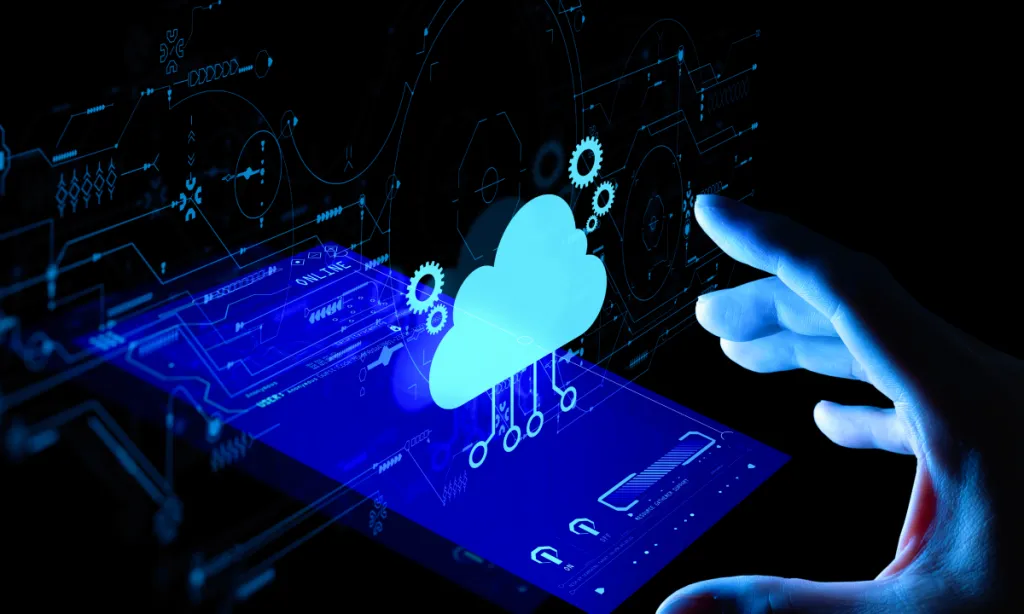Quick Overview
As cloud computing advances in 2025, key trends like cloud-native architectures, AI ops, multi-cloud adoption, edge computing, advanced security, sustainability efforts, serverless computing, and innovative storage solutions will reshape the landscape. Stay ahead by leveraging automation, flexibility, scalability, and energy efficiency from leading-edge cloud technologies and services to boost agility and responsiveness. We explore the top developments to watch.
In 2023, more than 90%% of businesses are using cloud solutions. The trajectory of this rapidly evolving technology raises the question: What lies ahead for the future of cloud computing?
As we move into 2025, groundbreaking innovations in cloud computing aim to boost flexibility, scalability, and sustainability like never before. According to cloud statistics, the top 3 cloud service providers market share grew 42% year over year.
Serverless computing, one of the common top cloud computing trends that enables developers to run code without managing servers, paying only for compute time used. This enables more agile deployment and scalability.
On the other hand, Edge computing brings data processing closer to devices, reducing latency. As IoT expands, edge computing will become more critical.
Multi-cloud adoption, another dominating cloud computing trend, is also a good option for businesses seeking to avoid vendor lock-in and optimize costs, performance, and features. Developing cloud-agnostic applications will be key to multi-cloud success.
Thus, enterprises must take advantage of these cloud trends to stay competitive. This blog post shares complete insights on the biggest cloud computing trends in 2025.
We’ll also share how partnering with experienced cloud application development service providers can help businesses navigate this complex, fast-evolving landscape.
Cloud Computing: Transforming the Digital Landscape
Cloud computing is transforming how businesses and individuals access and leverage data and applications, overturning changing the technology landscape with its ability to reshape IT delivery models.
Simply put, it involves accessing and storing information over the internet, eliminating the need for physical infrastructure. This virtualized approach offers unparalleled advantages, including scalability to meet fluctuating demands, universal accessibility from any device, and cost-efficiency through a pay-as-you-go model.
With robust measures such as encryption and multi-factor authentication, cloud security advancements are pivotal in ensuring data integrity.
Businesses can integrate their current on-premises infrastructure securely with customized cloud services, expanding their capabilities to include new assets through hybrid cloud solutions adoption.
Along with cloud computing services, renowned cloud providers like Microsoft Azure and AWS provide storage and software applications, so businesses don’t have to worry about managing complex infrastructure themselves.
As we navigate the evolving landscape of cloud computing trends, it’s clear that this paradigm shift is not just technological but a strategic imperative for those aiming to thrive in the modern digital age.
We offer tailored cloud solutions to meet your business needs, ensuring optimal performance and scalability.
Evolution of Cloud Computing
The genesis of cloud computing trends traces back to the late 20th century when the groundwork for this revolutionary technology was laid. The concept emerged as a response to the escalating demand for efficient and scalable computing solutions.
Early 2000s: Birth of Cloud Concepts
In the early 2000s, pioneers like Amazon AWS began experimenting with the idea of providing virtualized computing resources over the internet. This laid the foundation for what we now call cloud computing services. The goal was to offer businesses the ability to scale resources dynamically, a key precursor to the emphasis on scalability in cloud platforms.
Mid-2000s: Rise of Cloud Giants
By the mid-2000s, prominent players like Google and Microsoft entered the competition by introducing various services that laid the groundwork for today’s expansive cloud ecosystems. This era marked a turning point as the focus shifted from individual services to comprehensive cloud solutions.
Late 2000s to Present: Integration and Expansion
The late 2000s witnessed the convergence of cloud computing with emerging technologies, including integrating Artificial Intelligence in cloud services. This synergistic relationship drove the capabilities of cloud platforms, fostering innovation and efficiency.
The history of cloud computing is a tale of innovation, scalability, and integration. Today, the landscape is dominated by many providers offering diverse services.
Amazon AWS cloud computing services, synonymous with cloud excellence, remain a leader in providing top cloud services for enterprises, emphasizing the continual evolution of the industry.
Partner with ValueCoders to implement cloud trends innovations in your business.
Top Cloud Computing Trends in 2025
As we step into 2025, the realm of cloud computing trends unfolds with many advancements that promise to redefine the digital landscape. Let’s look into the top cloud computing trends to watch out for this year:
#1 Artificial Intelligence as a Service (AIaaS)
Artificial Intelligence as a Service (AIaaS) takes center stage in 2025, marking a significant evolution in utilizing AI capabilities. This trend enables businesses to leverage sophisticated AI tools and algorithms without requiring extensive in-house AI expertise.
Companies can now access AI functionalities through cloud platforms, allowing for the seamless integration of machine learning models into their applications.
This enables AI and facilitates quicker implementation of intelligent solutions, driving innovation in natural language processing, computer vision, and predictive analytics.
Also read: What Are The Top AI Software Development Tools?
#2 Cloud Native Development
The trend redefines how applications are built and deployed. Organizations are increasingly adopting containerized applications and microservices architecture, providing several benefits, including enhanced scalability, flexibility, and resource utilization.
Containers, orchestrated by tools like Kubernetes, ensure consistent performance across different environments, streamlining the development process.
Development and operations teams can collaborate and deliver new features and updates faster, aligning with DevOps principles with this approach.
As cloud-native development becomes the norm, it provides an environment of innovation and agility within organizations.
Also read: Top 20 Cloud Services Companies For Enterprises To Connect With
#3 Data as a Service (DaaS)
DaaS is emerging as a pivotal trend, responding to the need for efficient and easy data access. DaaS provides a framework for delivering data on demand, allowing organizations to access and utilize valuable insights without the complexities of managing and maintaining large datasets.
This trend promotes data democratization, enabling various departments to make informed decisions based on real-time, relevant data. By centralizing data management in the cloud, DaaS facilitates seamless integration with other cloud services, analytics tools, and machine learning algorithms, enhancing the overall efficiency of data-driven processes. Elevate your understanding of today’s cloud opportunities and integrate seamless cloud strategizing efforts. To stay adaptive, you might want to enroll in DataCamp’s cloud courses, where you’ll refine skills needed for a data-driven future. Discover concepts that prepare entities for real-time challenges, all under expert guidance that fosters growth and practical insight.
#4 Real-time Cloud Infrastructure
In 2025, the demand for real-time cloud infrastructure intensifies, driven by the increasing importance of instant data processing and analytics. Industries such as finance, healthcare, and e-commerce require immediate insights for critical decision-making.
Organizations can analyze and act on information as it unfolds using real-time cloud infrastructure due to its low latency and ability to process data quickly. This trend is particularly relevant in applications like fraud detection, monitoring IoT devices, and delivering personalized user experiences.
By leveraging real-time cloud capabilities, businesses can gain a competitive edge in today’s fast-paced digital landscape.
#5 Cloud Orchestration
Cloud orchestration becomes a focal point in optimizing complex workflows and automating tasks within cloud environments. Orchestrating these services becomes critical for efficient resource management as organizations adopt diverse cloud services.
Cloud orchestration tools enable various task coordination, ensuring seamless integration and interoperability between multiple cloud platforms. This trend simplifies the deployment and scaling of applications, enhancing operational efficiency and reducing manual intervention.
With cloud orchestration, businesses can adapt to changing workloads and optimize resource utilization, ultimately driving cost savings and improving overall agility.
Also read: Top Cloud Computing Trends That Will Shape Businesses In The Coming Years
#6 Cloud Innovation
Cloud innovation remains at the forefront of technological advancements in 2025. The cloud ecosystem continues to evolve rapidly, focusing on integrating emerging technologies such as Machine Learning, Augmented Reality, and Quantum Computing.
This trend is characterized by the development cutting-edge services and solutions pushing the boundaries of what is possible in the digital realm. Researchers and developers are heavily involved in the creation of cloud services, encouraging experimentation and exploration in the environment.
Businesses can access various tools and services with cloud innovation, helping them to stay ahead of their competitors and align with evolving market demands.
#7 Cloud Gaming
The intersection of cloud computing and gaming takes center stage as cloud gaming gains prominence in 2025.
This trend revolutionizes the gaming industry by allowing users to access high-performance gaming experiences directly through the cloud, eliminating the need for robust local hardware.
Cloud gaming platforms leverage the power of scalable cloud computing to stream games with low latency, providing gamers with an engaging experience across different devices without lags or disruptions. This not only expands the accessibility of gaming but also introduces new possibilities for social gaming experiences and interactive content.
ValueCoders' expertise ensures a smooth and immersive gaming journey across multiple devices
#8 Multi/Hybrid Cloud
Multi/hybrid cloud solutions continue to evolve, catering to the diverse requirements of businesses seeking a balance between on-premises, private, and public cloud services.
This trend allows organizations to tailor their cloud strategy based on specific requirements, such as data sensitivity, compliance, and performance. Businesses can achieve optimal flexibility and scalability by seamlessly integrating different cloud environments.
Multi or hybrid cloud solutions enable efficient workload management, ensuring each application or service resides in the most suitable cloud environment. This approach enhances resilience, mitigates risks, and provides a strategic framework for IT infrastructure management.
#9 The Internet of Things (IoT)
Integrating the Internet of Things with cloud services will gain momentum in 2025, fostering enhanced connectivity and data management for IoT devices.
Cloud computing is critical in processing and analyzing the massive real-time data generation for IoT devices. This trend enables organizations to derive actionable insights, monitor device performance, and implement predictive maintenance strategies.
Cloud-based IoT platforms facilitate seamless communication between devices, allowing for efficient coordination and control. The combination of cloud computing and IoT empowers businesses to explore the full potential of connected devices, leading to improved operational efficiency and innovative product offerings.
#10 Kubernetes
In 2025, Kubernetes will solidify its position as a fundamental technology in the cloud computing landscape. This open-source container orchestration platform simplifies containerized applications’ deployment, scaling, and management.
Kubernetes provides a standardized and portable way to automate the deployment of applications across different environments, contributing to the consistency and reliability of cloud-native architectures.
Its popularity stems from the ability to abstract complexities associated with containerized applications, allowing organizations to focus on development rather than infrastructure management. As a result, implementing Kubernetes best practices plays a pivotal role in promoting agility, scalability, and efficient resource utilization.
#11 DevSecOps
DevSecOps becomes integral to the software development lifecycle in 2025, emphasizing the integration of security practices into the DevOps consulting services process.
This trend acknowledges the importance of security as a shared responsibility throughout the development pipeline. Organizations can identify and work on potential risks before deployment by embedding security measures early in the development cycle.
DevSecOps ensures a holistic approach to security, encompassing threat modeling, code analysis, and continuous monitoring. This proactive stance minimizes security risks, accelerates secure software release, and fosters collaboration between development, security, and operations teams.
Also Read: Cloud Computing in Manufacturing: Solutions to Stay on Top
#12 FinOps
FinOps emerges as a critical practice in 2025, addressing the financial aspects of cloud usage and optimizing costs.
This trend emphasizes the collaboration between finance, operations, and IT teams to achieve financial responsibility in the cloud. FinOps principles involve understanding cloud costs, allocating expenses, and implementing strategies for efficient resource utilization.
By adopting FinOps, organizations can balance innovation and cost-effectiveness, aligning cloud spending with business objectives. This approach ensures transparency in cloud costs, enabling informed decision-making and promoting a culture of financial accountability.
#13 Low-code and No-code
Low-code and no-code development platforms witness increased adoption in 2025, empowering individuals with limited coding skills to create applications efficiently.
This trend democratizes app development, enabling business users and citizen developers to contribute to creating software solutions. Simplifying the development process and decreasing the reliance on traditional coding low-code platforms provides visual interfaces and pre-built components.
No-code platforms take this concept further by eliminating the need for coding altogether, allowing users to build applications through a graphical interface. These platforms accelerate the application development lifecycle, fostering innovation and collaboration across departments.
Also read: Top Low-Code Platforms: PowerApps, Mendix, OutSystems, Appian, Pega
#14 Secure Access Service Edge (SASE)
In 2025, SASE will transform network security architectures by converging WAN capabilities with advanced security functions in the cloud. This trend addresses the evolving needs of organizations with a distributed workforce by providing secure and direct access to cloud services.
You can create an integrated, cloud-native security solution using SASE’s zero-trust network access, secure web gateways, and firewall-as-a-service.
By consolidating security services in the cloud, SASE solutions simplifies network architecture, improves user experience, and enhances overall security posture.
ValueCoders integrates advanced technologies, driving productivity and innovation in your business.
How ValueCoders Can Help You?
As we’ve explored, cloud computing trends in 2025 are poised to enable new levels of scalability, automation, flexibility, and sustainability. Critical innovations lie ahead, from multi-cloud and AI-ops to edge computing and serverless solutions.
Key Takeaways:
- Adopt an API-driven multi-cloud architecture for optimal flexibility, compliance, and costs
- Leverage AI-ops and auto-scaling to boost efficiency and manage complex cloud environments
- Evaluate edge computing and 5G to reduce latency and unlock IoT use cases
- Consider carbon-efficient cloud infrastructure automation to meet sustainability goals
Ready to harness these cutting-edge cloud capabilities? At ValueCoders, our experts can help you navigate the latest cloud computing trends and develop future-proof solutions tailored to your growth, innovation, and efficiency needs. Contact us today to future-proof your business!





















